Spain conjures up images of sandy beaches and long coastlines, football and siesta. But there are several landmarks in Spain that give the most popular attractions in Europe solid competition.
Especially if you’re a history buff, Spain is home to many monuments that have played a strategic role in what the country and continent are, today.
From Gaudi’s Sagrada Familia to the Golden Triangle in Madrid, Spain has an eclectic mix of cathedrals, museums, art galleries, and several other architectural and cultural landmarks.
[You Might Like: 42 Fun Facts About Spain That Will Borderline Amaze You]
49 Most Famous Spain Landmarks
In fact, Spain has a collection of 48 UNESCO World Heritage Sites – the third largest in the world!
This article gives you a low-down of the top Spain landmarks you should know of, and visit, on your next trip to the country.
LANDMARKS IN BARCELONA
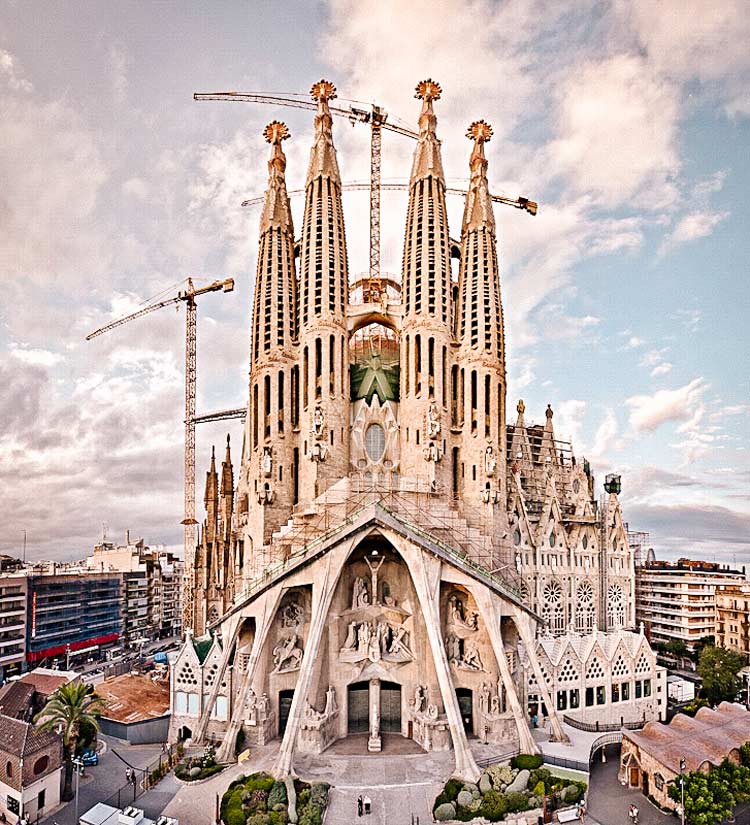
1. La Sagrada Familia, Barcelona
This Basilica is easily the most famous monument in Barcelona, perhaps even in Spain.
La Sagrada Familia was created by one of the greatest Spanish architects, Antoni Gaudi. The construction of the Sagrada Familia began in 1818, and was Gaudi’s chef d’oeuvre.
The Basilica was never completed though, in fact it is still under construction.
Jordi Fauli, the current architect working on the project, estimates the completion of Sagrada Familia by 2026. The original designs from Gaudi are being followed.
That said, it is still open to visitors who can take a tour around Sagrada Familia, and admire the Chapel of San Jose, the door of El Nacimiento and the Crypt.
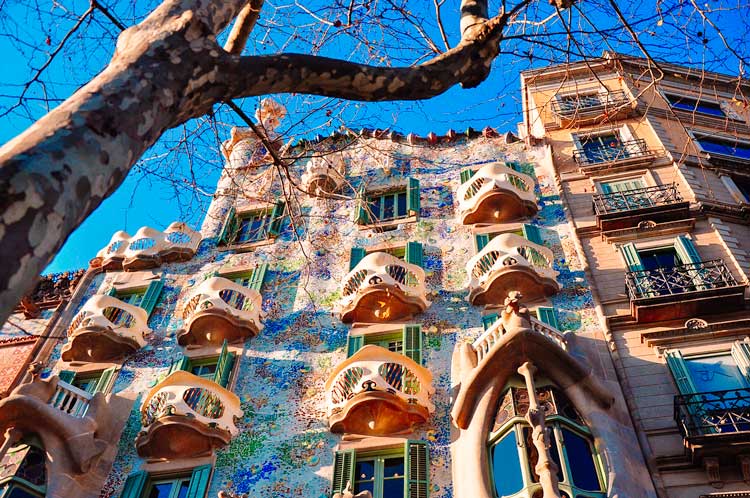
2. Casa Batllo, Barcelona
Casa Batllo is another one from the list of Gaudi’s creations and was declared a UNESCO World Heritage Site in 1984.
Also called Casa dels Ossos (House of Bones), the building has a unique skeletal architectural style which can be described as Art Nouveau.
The facade is detailed with a mosaic made from broken ceramic tiles. The modernist exterior of the building itself is breathtaking.
The interiors are symbolic of a fantasy world with lots of colors and effects to instantly stimulate your senses. Lots of asymmetrical designs and intricate sculpted stonework embellish every part of Casa Batllo.
While you are there, make sure to look up as the arched roof has been styled as the back of a dragon.
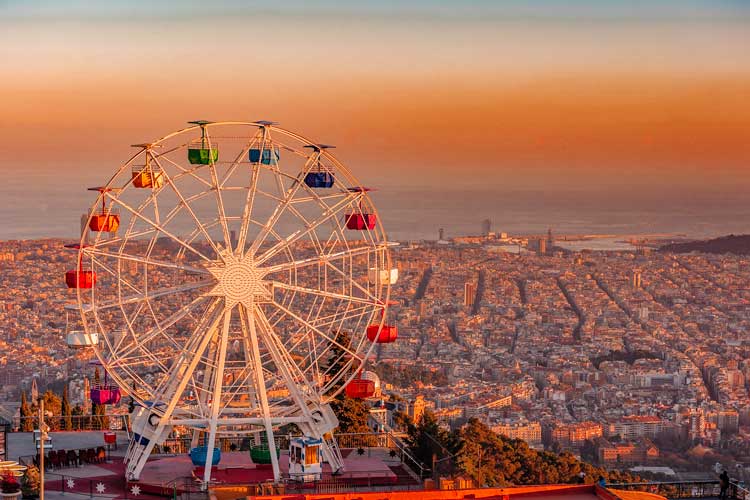
3. Parc d’Atraccions Tibidabo, Barcelona
Tibidabo Amusement Park has been running for over 100 years, and is one of the oldest functional parks in the world.
It is also Spain’s longest (and Europe’s third-longest) running park.
The most popular ride is the 1928 Avió airplane, which simulates a flight between Barcelona and Madrid. This might not seem like a big deal, but it was a novelty back in the day.
Tibidabo Amusement Park, or Parc d’Atraccions Tibidabo, is not only an important landmark in Spain, but is also a great choice of destination if you’re traveling to Barcelona with kids.
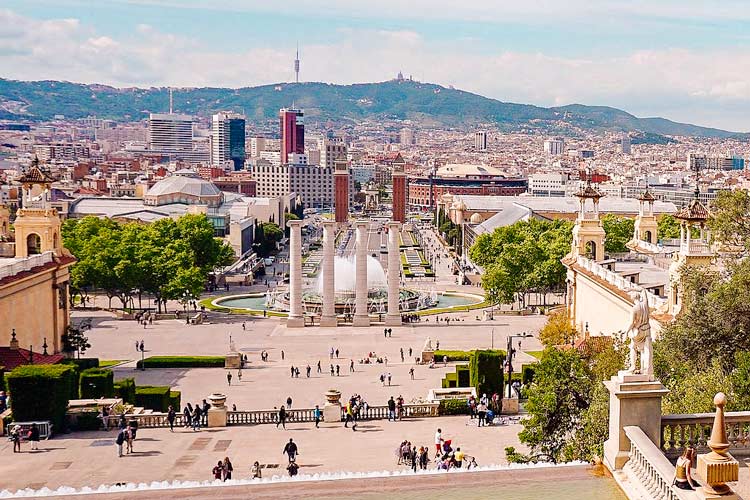
4. Font Màgica de Montjuïc, Barcelona
Font Màgica, or the Magic Fountain, is situated on Montjuïc Hill in Barcelona.
Also known as Fuente mágica de Montjuic – the fountain was built for the 1929 Barcelona International Exposition. It was designed by Carles Buïgas.
The park is best known for its water display, with lights and music, which takes place in the day during the summer months and at night during the winter.
The fountain consists of a concrete base and an octagonal water tank, the whole structure supported on three levels of slender white pillars. There is room for spectators to sit around the periphery in a walkway that surrounds the pool itself.
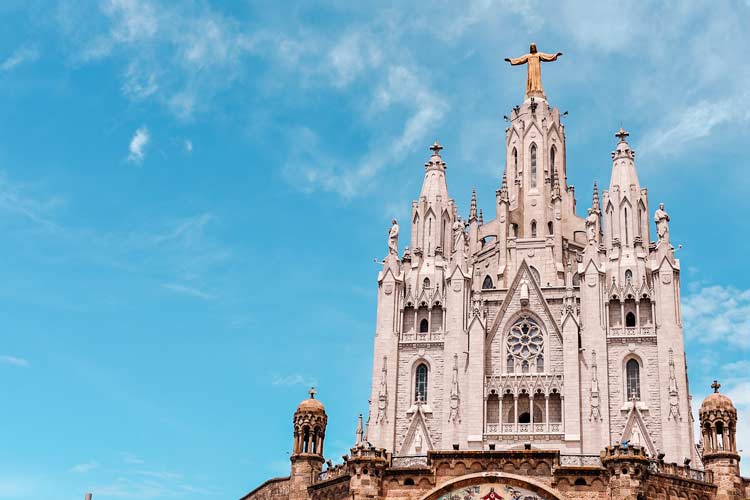
5. Expiatori del Sagrat Cor, Barcelona
The Expiatory Church of the Sacred Heart of Jesus, or commonly called Tibidabo Cathedral, is a Roman catholic church built on the top of Mount Tibidabo. It is located next to the Tibidabo Amusement Park.
Built by Spanish architect Enric Sagnier, the church’s construction began in 1902. It took a total of 60 years to complete.
The thing that stands out in the Tibidabo Cathedral is the bronze state of Jesus Christ hoisted at its top, designed by Josep Miret Llopart.
The church has an elevator that takes you to the top. From here, you can enjoy panoramic views of Barcelona.
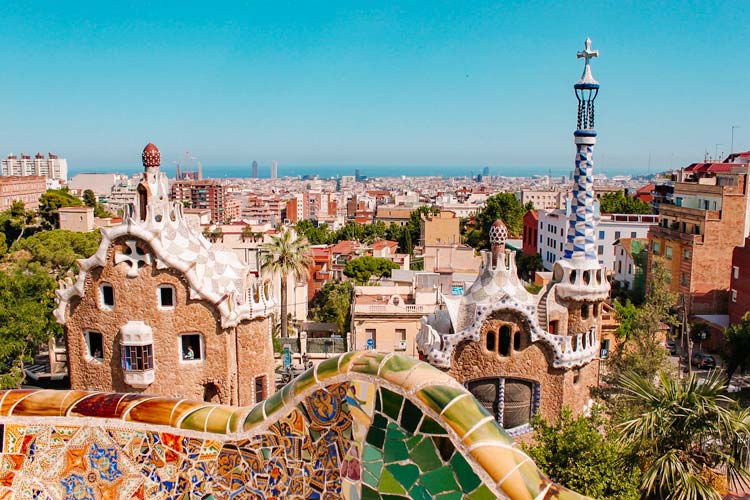
6. Parc Guell, Barcelona
Parc Guell is a park complex located on Carmen Hill in Barcelona.
A UNESCO World Heritage Site, the park was designed by Antoni Gaudi and opened to the public in 1926.
The park style is quintessentially Gaudi-esque and spans a whole range of geometrical and chromatic abundance. Gaudi was known to play with volumes and structures, and his organic style is beautifully exhibited in the park’s architecture and framework.
Parc Guell is a huge tourist magnet, and one of the most famous landmarks in Spain.
Best part: It is free to visit!
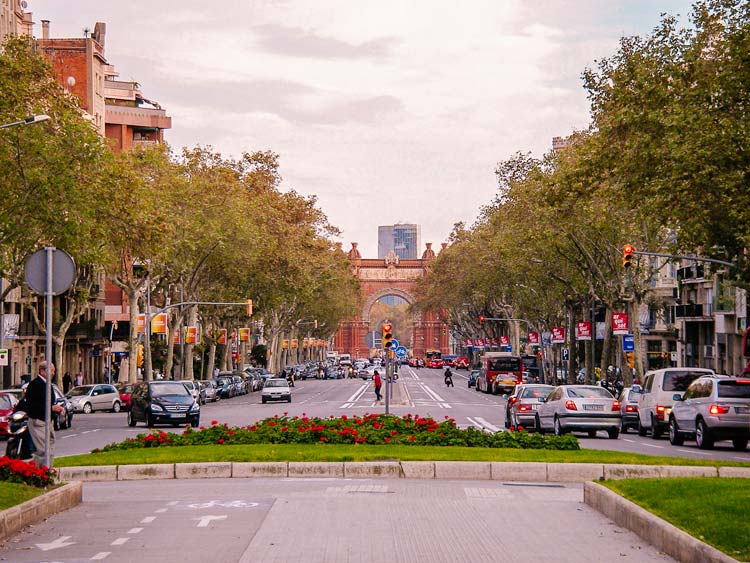
7. La Rambla, Barcelona
One of the most famous streets of Barcelona, La Rambla stretches over 1.2 km between the neighborhoods of Barri Gòtic and El Raval.
The street runs through the heart of Barcelona’s city center and is lined with kiosks selling everything from newspapers and flowers to souvenirs. There are also a lot of corner cafes and bars.
Along the Rambla, you can find important landmarks of interest like the Virreina Palace and the Liceu Theater. The La Boqueria market is also nearby.
At present, La Rambla is almost always full of tourists, but it’s been romanticized by poets and writers in the past.
The Spanish poet Federico García Lorca famously said, “La Rambla is the only street in the world which I wish would never end”.
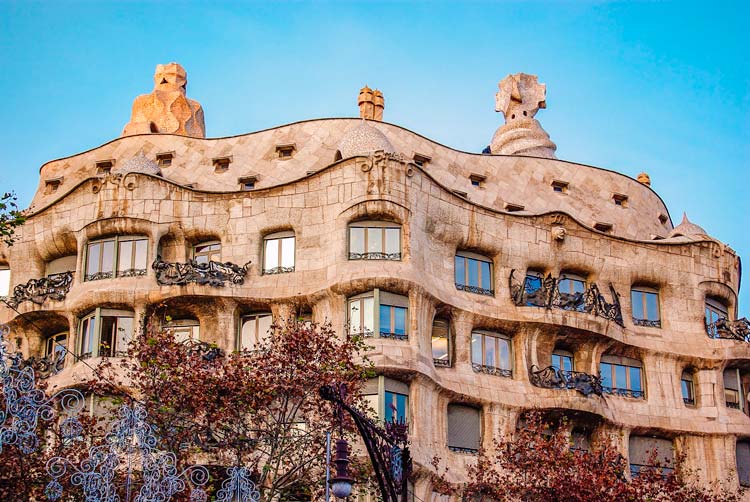
8. Casa Milà, Barcelona
The Casa Mila, also called “The Stone Quarry” because of its coarse, rough look, is an important modernist building in Barcelona.
A famous Spain landmark, the Casa was built for and named after Roser Segimón and her husband Pere Milà.
Constructed between 1906 and 1912, it was the last private residence designed by Antoni Gaudi.
Casa Mila is important because it offers a peek into the lifestyle of the Barcelona Bourgeoisie at the time.
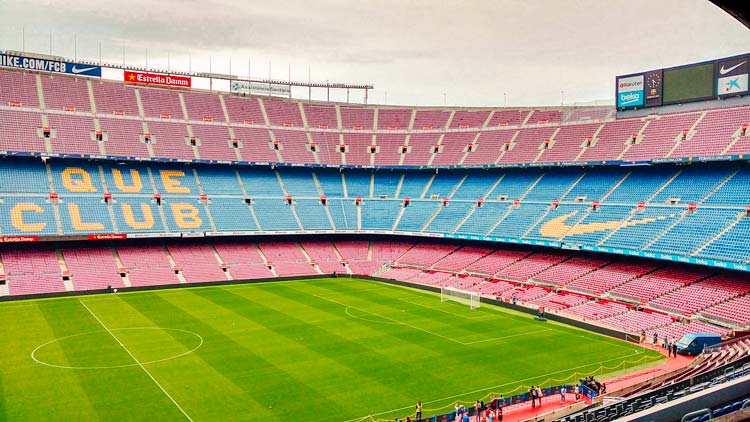
9. Camp Nou, Barcelona
Camp Nou is the home stadium of the football club FC Barcelona.
It has a seating capacity of over 99K, making it the largest stadium in Europe and the fourth largest in the world.
If you’re a football fan, you will love visiting Camp Nou. Heck, if you’re a football fan you’ll love visiting Spain anyway!
But it’s especially worth taking a tour of Camp Nou, where you can walk through the players’ tunnel, enjoy panoramic views of the stadium, and leave your stamp in areas exclusively accessible to the players.
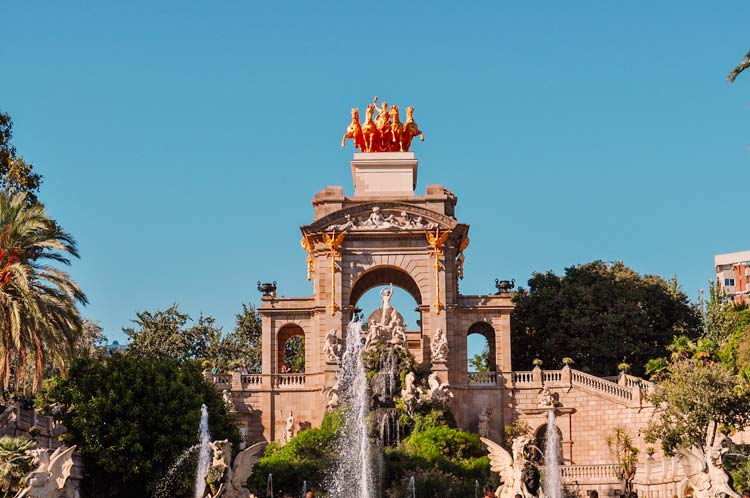
10. Parc de la Ciutadella, Barcelona
Parc de la Ciutadella, or City Park, is located in the Ciutat Vella district of Barcelona. It is the city’s oldest park. For several decades through the 19th century, the park served as Barcelona’s only green space.
The City park houses in it the Barcelona Zoo, museums, a lake, the assembly hall for the Catalonian Parliament, and most notably, a prominent fountain designed by Joseph Fontserè and Antony Gaudi.
City Park is free to enter, and you can also go boating in the lake. Next to the fountain is a small cafe to relax at.
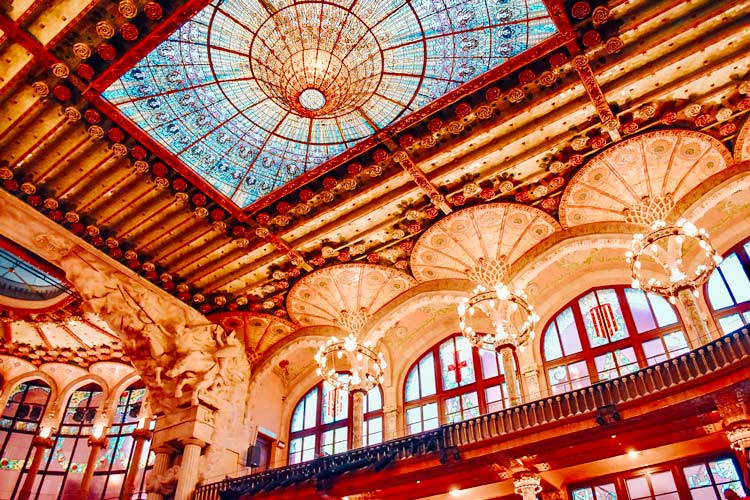
11. Palau de la Música Catalana, Barcelona
The Palace of Catalan Music is a concert hall designed by the famous Spanish architect, Lluís Domènech i Montaner, in quintessential Catalan modernist style. It was built between 1905 and 1908.
From the outside alone, the palace is spectacular, with its brilliant Art Nouveau architecture that is a pleasant contrast from the nearby buildings.
However, the interior of Palau de la Música is a must-visit to truly acknowledge its architectural splendor. Filled with vibrant floral mosaics, glazed ceramic moldings, and stained glass panes embedded in perfect arches, the palace has myriad fine details that are a treat to look at.
Palau de la Música is a UNESCO World Heritage site and one of the most popular landmarks of Spain.
Guided tours run for just under an hour and I highly recommend doing a tour. It’s every bit worth it.
LANDMARKS IN MADRID
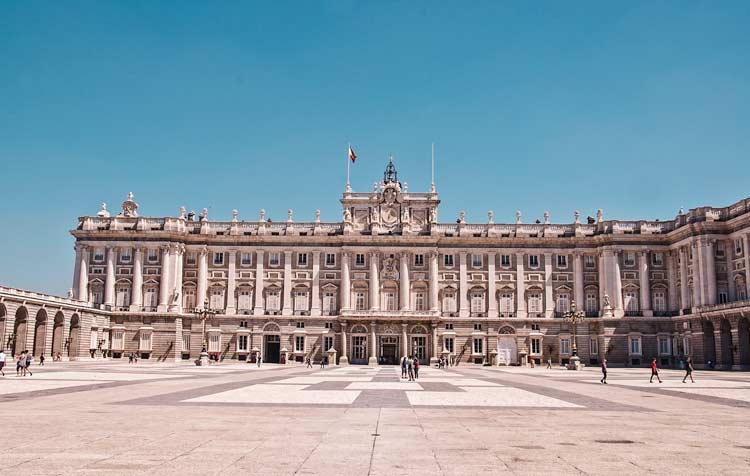
12. Palacio Real, Madrid
Palacio Real, or the Royal Palace, is the official residence of the Spanish royal family, although they live in the relatively modest Palace of Zarzuela in the suburbs. The palace is presently used for state ceremonies.
The current palace is built in lavish Baroque style over the remains of a 9th-century fortress.
Palacio Real is huge, and it screams opulence. With over 3000 rooms spread across six floors and 135,000 square meters, it is the largest royal palace by floor area in all of Europe.
A key feature of the palace is the main staircase, designed by Francesco Sabatini. The Throne Rooms and the Gala Dining Room are the epitome of luxury and wealth.
A visit to the Royal Palace in Madrid is a must to experience the flamboyance that was accorded to Spain’s royal families in the past.
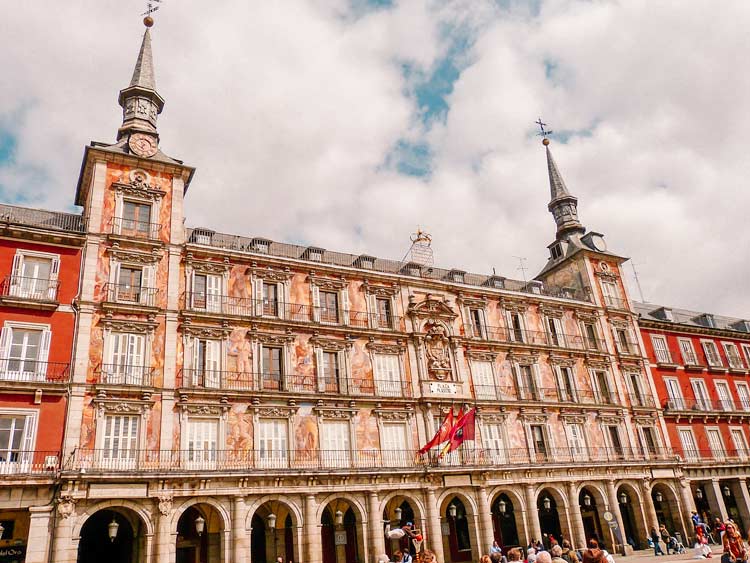
13. Plaza Mayor, Madrid
Plaza Mayor not only enjoys historical relevance in Spain, but is also a popular meeting point in Madrid for locals as well as tourists.
Built during the reign of Philip III, whose statue aboard a magnificent stallion sits in the plaza’s center.
The plaza is surrounded by orange-red-hued Baroque buildings and is lined with cute cafes.
The square formerly hosted the main market of Madrid.
When you’re in Madrid, visit the Plaza Mayor, grab a spot at a cafe, and spend some time people-watching.
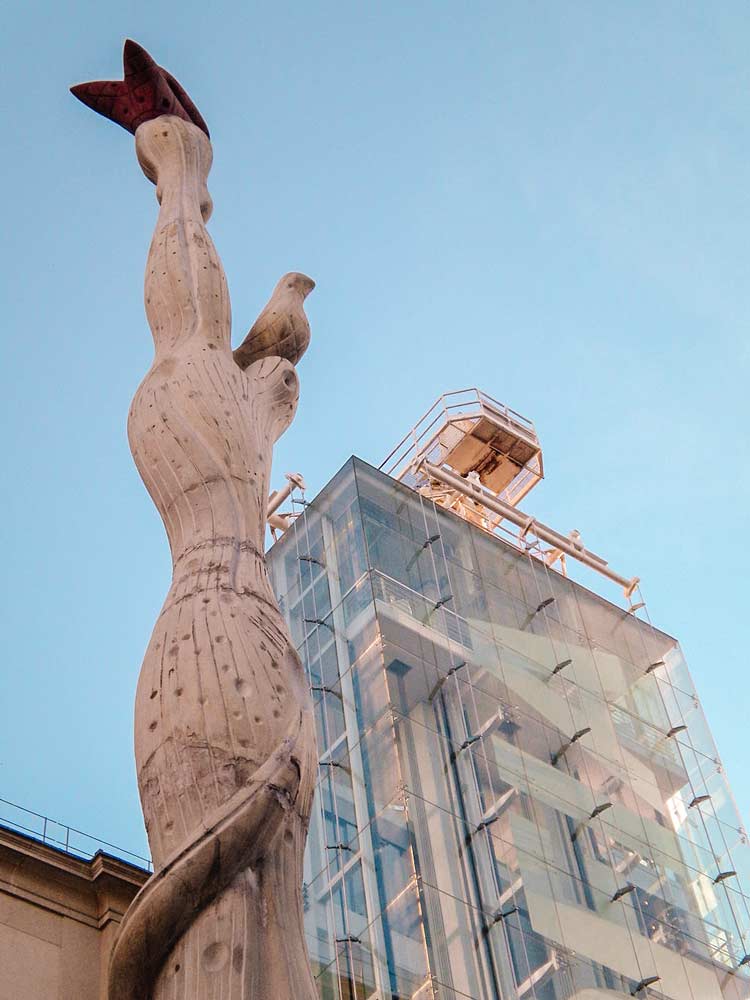
14. Museo Nacional Centro de Arte Reina Sofía, Madrid
Founded in 1990, the Reina Sofia Museum contains the biggest and most significant collection of Spain’s 20th century art. Especially worth noting are the creations of 20th century’s two biggest artists, Pablo Picasso and Salvadore Dali, including Picasso’s 1937 painting Guernica.
The museum is named after Queen Sofia, a member of the Royal Family and a former Queen of Spain.
Although the permanent collection focuses on Spanish art, the museum also has temporary exhibitions for national and international artists.
Reina Sofia is one of the world’s largest museums for modern and contemporary art, and the sixth most frequented art museum in the world!
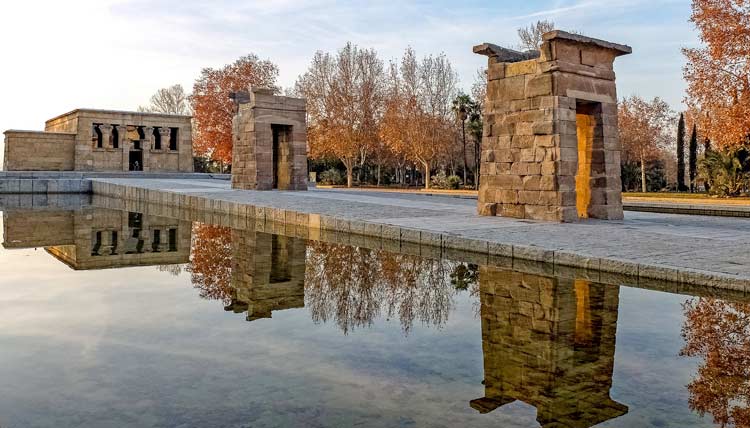
15. Templo de Debod, Madrid
One of Spain’s most popular landmarks, Templo de Debod is an Egyptian temple located in Madrid’s La Montaña Park.
The temple was originally built in the 2nd century in Egypt. However, in the 1960s, as a token of thanks to Spain for their help in saving the Abu Simbel temples, the Egyptian government donated the Templo de Debod to the country.
The temple was deconstructed in Egypt and sent to Spain in pieces. It was reconstructed and finally opened to the public in 1972.
Templo de Debod is an important and rare example of an Egyptian cultural monument preserved in a location completely outside of its origin.
The temple is free to enter and is a great location to catch a stunning sunset in Madrid.
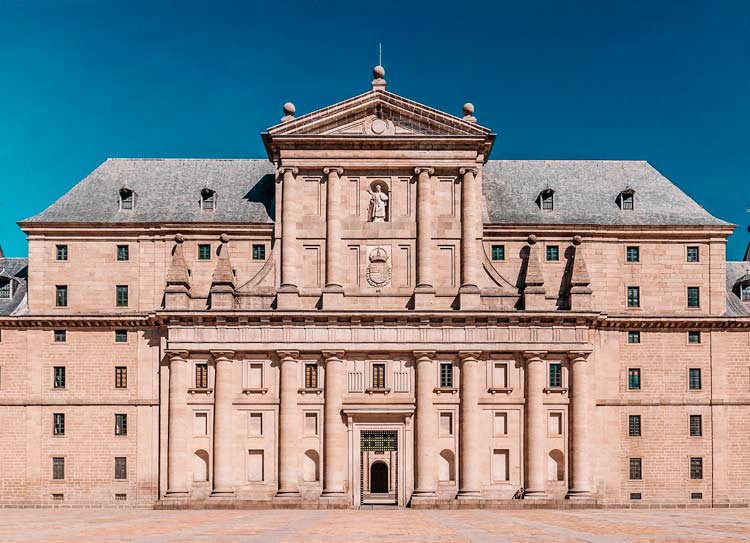
16. Monastery of El Escorial, Madrid
San Lorenzo de El Escorial is a Spanish town situated in the heart of the Guadarrama mountains. It is also commonly called El Escorial de Arriba, or simply, El Escorial.
The Royal Monastery in the town is one of the most important monuments representing the Renaissance in Spain. It is a sprawling complex that includes the King’s courtyard, a Basilica, library, and cottage gardens besides other sections. In that sense, the monastery represents the culmination of monarchial values, faith, arts, and knowledge.
Every part of the complex depicts the skillfulness and architectural brilliance of the Spanish ‘Golden Age’.
In 1984, the El Escorial Monastery and its historic surroundings were declared a UNESCO World Heritage Site. It has also been included in the Spain Heritage Register since 2006 as a Property of Cultural Interest, and enjoys special protection as part of this status.
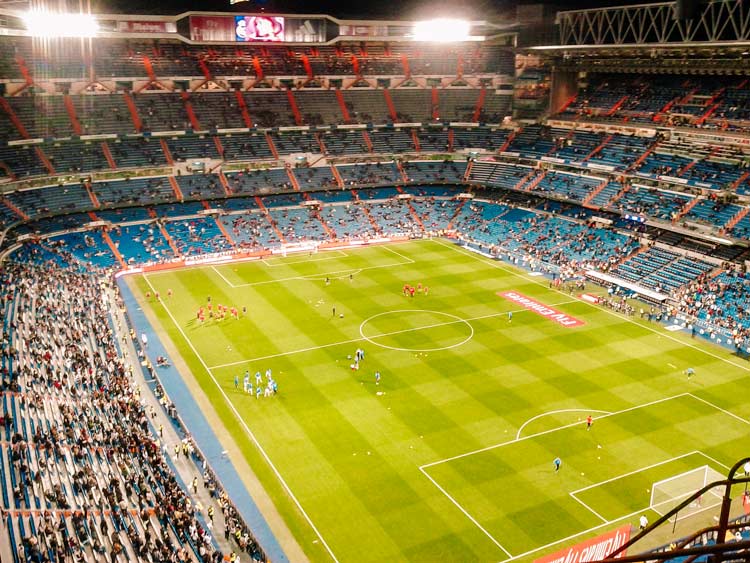
17. Real Madrid Santiago Bernabeu Stadium
The Santiago Bernabeu Stadium has been home to the Real Madrid football team since 1947.
With a seating capacity of 81,044, it is the second-largest football stadium in Spain after Camp Nou, and one of the largest major football club stadiums in Europe.
Santiago Bernabeau is a major attraction and a must-visit for Real Madrid fans, especially. You can take a guided tour which includes a visit through the museum and access to the players’ tunnel, trophies, and dressing room. You can also enjoy panned out views of the stadium as part of the tour.
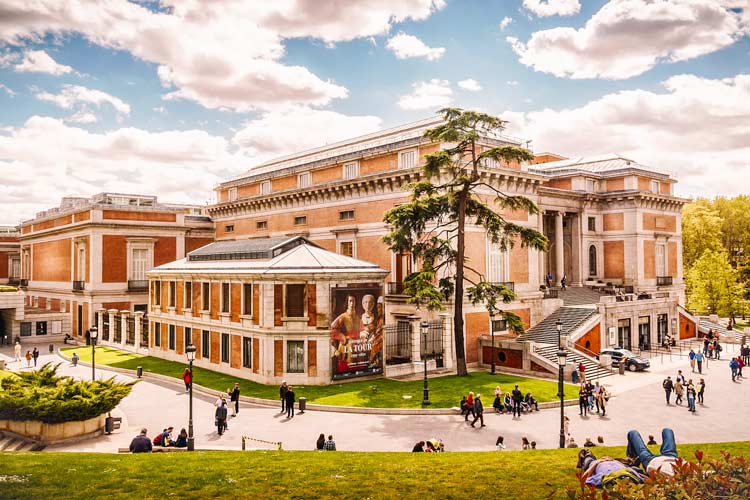
18. Museo Nacional del Prado, Madrid
Museo Nacional del Prado, or Prado Museum is Spain’s main national art museum.
Located in downtown Madrid, it contains one of the finest and largest collections of European art, ranging from the 12th century until the 20th century.
In 2020, Prado was ranked the 16th-most visited museum in the world. The collection includes Albrecht Dürer’s 1507 Adam and Eve, and Caravaggio’s David and Goliath (1600).
The Prado Museum completed its 200th anniversary in 2019, and has been consistently drawing millions of art buffs from all over the world every year.
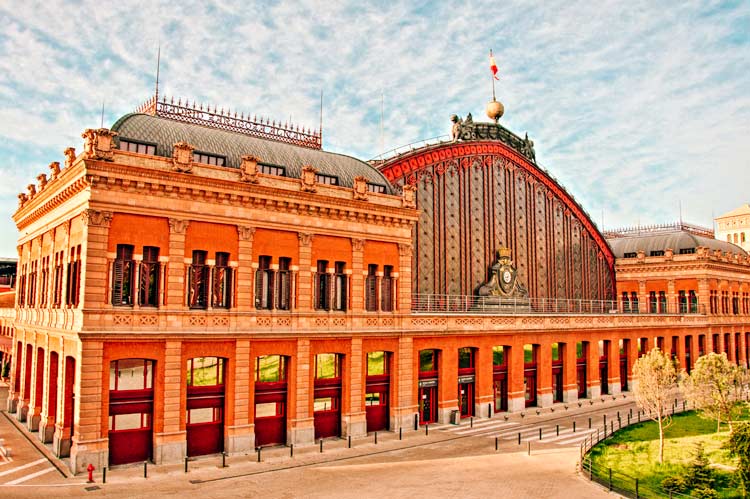
19. Estacion de Atocha, Madrid
Estacion de Atocha, or Madrid Puerta de Atocha, is the largest and oldest railway station in Madrid.
Because of its central location, the station is a point of confluence for all sorts of trains running across the length and breadth of the country.
Originally designed by Rafael Moneo in 1851, the station was destroyed by a fire outbreak in 1892. Thereafter, it was redesigned by Eiffel Gustave (man behind the Eiffel Tower) and Alberto de Palacio Elissagne.
To get the full experience of this famous landmark of Spain, see if you can book a train via the Estacion de Atocha. The station by itself is a delight to explore, with its unique wrought-iron architecture, and steel and glass roofs. There is also a botanical garden spread over 2,000 square meters, that you can visit.
LANDMARKS IN SEVILLE
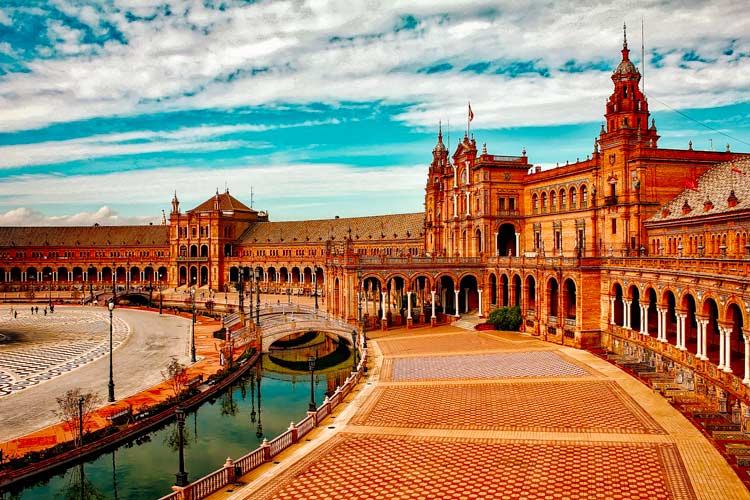
20. Plaza de Espana, Seville
Literally translating as “Spain Square”, Plaza de Espana is a plaza/boulevard in the María Luisa Park in Seville.
Built in 1928, it is a masterpiece that brings together the Baroque , Renaissance , and Moorish elements of Spain’s extremely diverse architecture.
It presently houses government offices and is surrounded by gorgeous gardens.
The most striking feature of the plaza is the Spanish Pavillion, the semi-circular structure lined with golden buildings.
The alcoves along the plaza’s wall are decorated with blue tiles that represent all the provinces of Spain in alphabetical order.
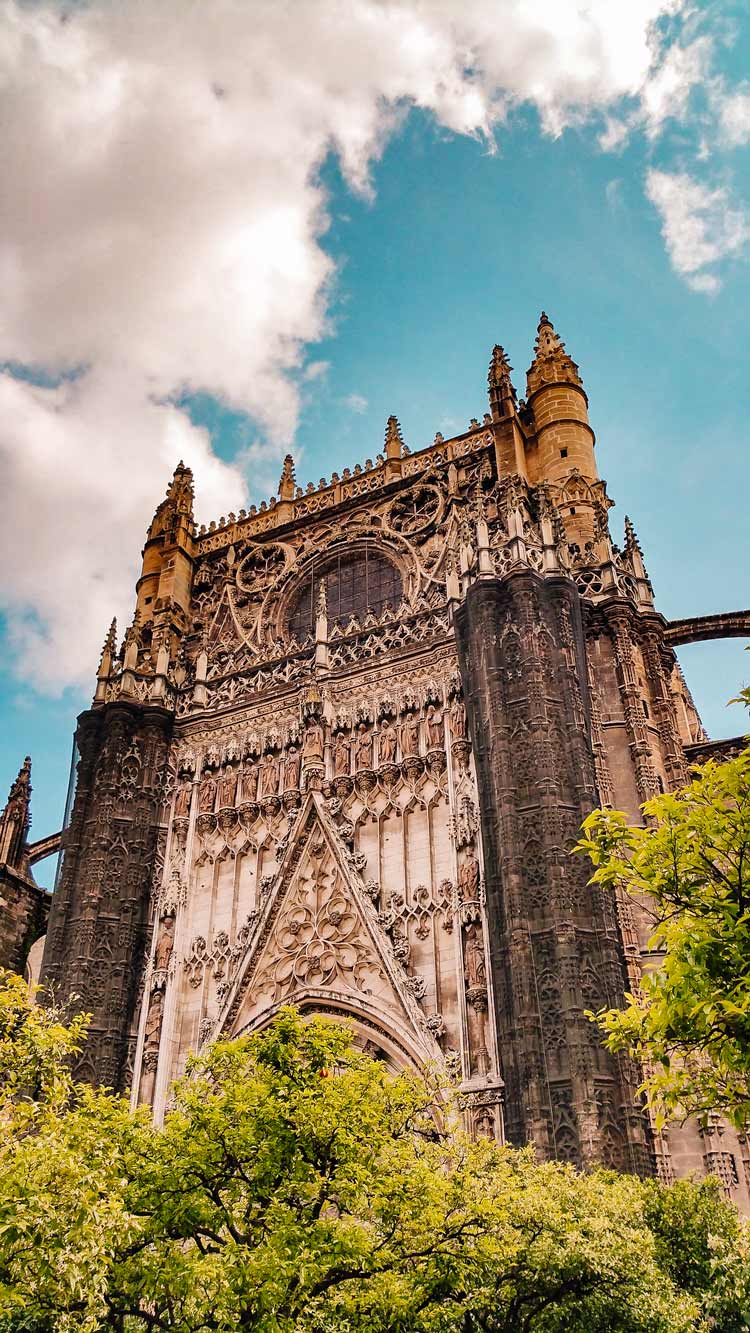
21. Catedral de Santa María de la Sede, Seville
Better known as the Cathedral of Saint Mary of the See, or simply, Seville Cathedral, this UNESCO World Heritage Site symbolizes the Reconquista – the reconquest of the Christians over the Moors.
The cathedral was formerly a mosque, before it was built as a church in the 15th century. Today it is one of the world’s largest, and is a paradigm for Gothic architecture in Spain.
Seville Cathedral is also the resting place of Christopher Columbus, whose tomb sits inside and is a popular tourist attraction.
The Cathedral of Seville is Spain’s third-largest church, after the Cathedrals of Toledo and Burgos, and the fourth largest church in the world. It took 170 years to build the cathedral! Spain’s first Renaissance artist, Diego de Riaño, designed the famous dome that rests above the altar area.
A guided tour of the cathedral leads you through many areas like Santa Ana Chapel, which showcases Renaissance work, and also the Royal Chapel, which is where Spain’s monarchs were crowned and entombed.
Don’t miss La Giralda, the bell tower of the cathedral. The tower was built as a minaret for the mosque. The Renaissance style-top was added later when the city was acquired by Christian forces.
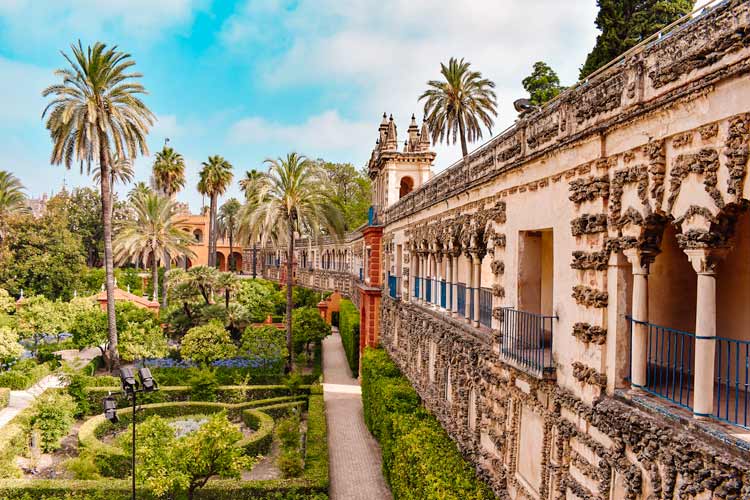
22. Real Alcázar, Seville
Real Alcázar is a royal palace in Seville, that signifies the confluence of various architectural styles. The structure was originally built as a Muslim fortress in 889 called al-Qasr al-Muriq. The fortress was destroyed in the 13th century, and the palace was built at the site.
The Alcazar of Seville is a fine example of Mudejar art in Spain, which is a combination of Moorish, Christian and even Byzantine architecture. It is one of the oldest royal palaces in Europe.
For most visitors, Seville’s Royal Alcázar often tops the list of things to do in the city. The Alcázar is a symbol of Seville and it sits at its highest point, overlooking the main square, Plaza de España.
Real Alcázar de Sevilla was declared a UNESCO World Heritage Site in 1987 and continues to be one of the most famous Spanish landmarks to visit.
HISTORICAL LANDMARKS IN SPAIN
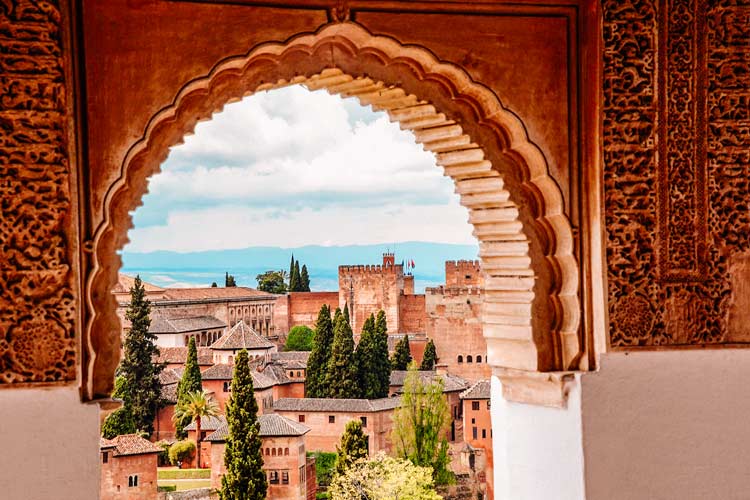
23. Alhambra, Granada
Translating in Arabic to ‘The Red One’, because of its red-orange hue, Alhambra is a hugely famous landmark in Spain.
This is a palace and fortress complex signifying the country’s Moorish architecture and heritage spanning over 700 years.
Alhambra has four main sites: The Royal Palaces, the Alcazaba, the court of the lions and the Generalife Gardens.
Sitting on Sabikah Hill, the palace offers sweeping views of Granada from the top.
The Alhambra was declared a UNESCO World Heritage Site in 1984. Today it’s one of the main attractions in Granada.
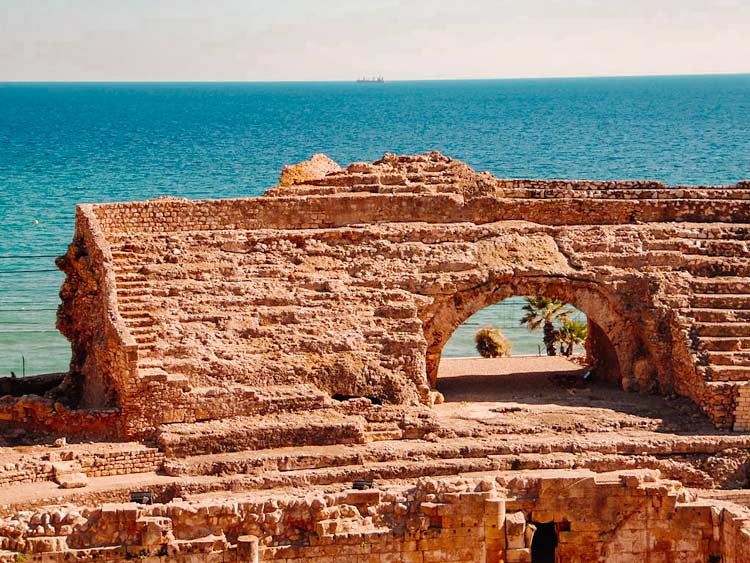
24. Tarragona Romana, Catalonia
Tarragona is a Spanish city which was previously a Roman settlement by the name Tarraco. It was the first Roman settlement in the Iberian Peninsula, and hence the oldest.
Tarraco was founded by the Carthaginians in 228 BC. The city rose to great prominence in Roman times, when it became the capital of Hispania and an important port for trade.
Tarragona is renowned for its large archeological sites which include an amphitheater, a circus and several temples.
The Roman ruins of Tarragona are a UNESCO World Heritage Site.
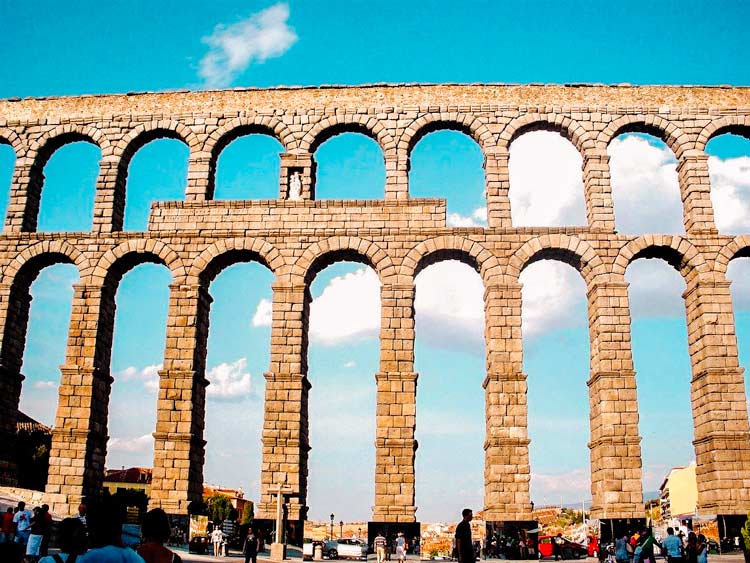
25. Aqueduct of Segovia
This is a Roman aqueduct located in Segovia, Spain. Built during the 1st century to supply water to the city of Segovia, the still-functioning aqueduct is one of the world’s oldest.
The aqueduct is especially important to the city of Segovia, and is also placed on the city’s coat of arms.
The Aqueduct of Segovia was used to carry water from the Rio Frio river to Segovia over a distance of over 20 miles.
It is a spectacular example of Roman architecture. It consists of more than 160 arches and covers a length of almost 800 meters.
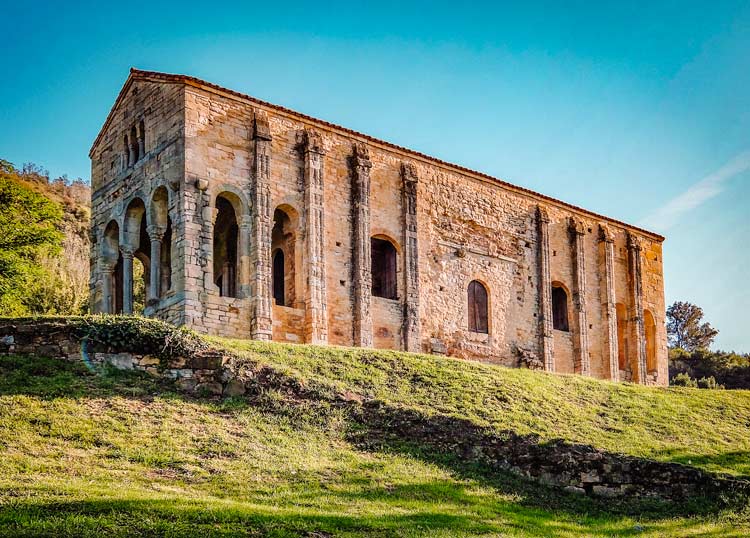
26. Monuments of Oviedo, Asturias
These are a set of monuments built in Oviedo, in the (then) kingdom of Asturias. The constructions date back to the 9th century, when Asturias was at the cornerstone for Christianity in Spain.
Oviedo’s most famous monument is the Cathedral of San Salvador, or the Oviedo Cathedral, which was built in the 13th century. Its tower has been used as an observatory for centuries.
Another one is the Monastery and Church at Santa Maria del Naranco, a 12th-century church built into a steep rock face of Mount Naranco.
Oviedo monuments display romanesque and pre-romanesque architecture and artwork of great historical relevance.
The city of Oviedo and the Kingdom of Asturias were included in the UNESCO World Heritage Sites list in 1985.
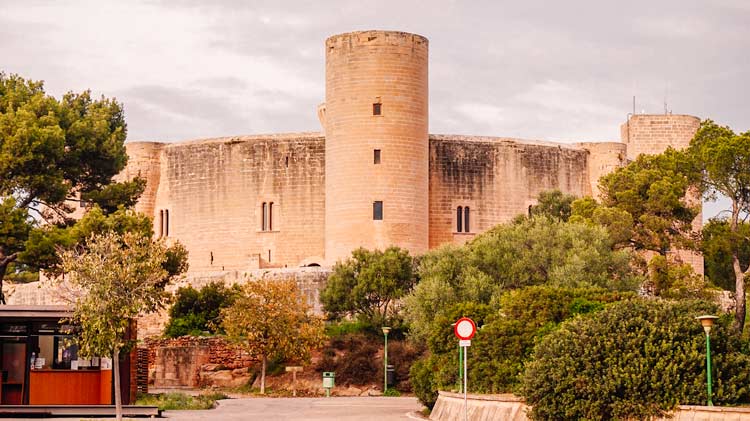
27. Castell de Bellver, Mallorca
Bellver Castle is a 14th century Gothic castle located in Mallorca which is part of the Balearic Islands. The castle is situated to the west of Palma, Mallorca’s capital.
It is one of the only few circular castles in Europe, which makes it a significant and famous Spanish landmark.
Though the castle originally served as the residence for Mallorcan kings, it was used as a military prison through the 18th-early 20th century period.
At present, Bellver Castle houses the History Museum of Palma, and is a major attraction on the island.
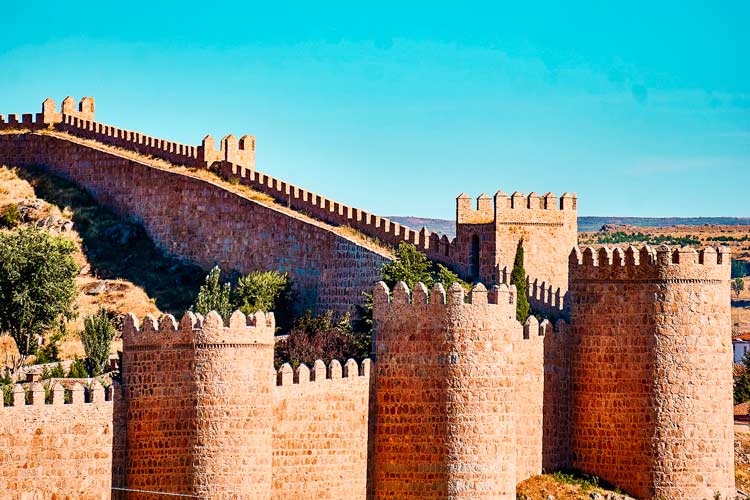
28. The Walls of Avila
Also called Muralla de Avila, the walls of Avila were constructed between the 11th and 14th centuries to defend the city. Built in grand Romanesque style, the walls have long been standing through the ever-changing history of the country.
Avila is also called the Town of Stones and Saints, and is said to have the highest number of Romanesque and Gothic churches per capita in Spain.
The city of Avila was declared a UNESCO World Heritage Site in 1985. In addition to the medieval walls, there are churches and old streets preserved over several hundred years.
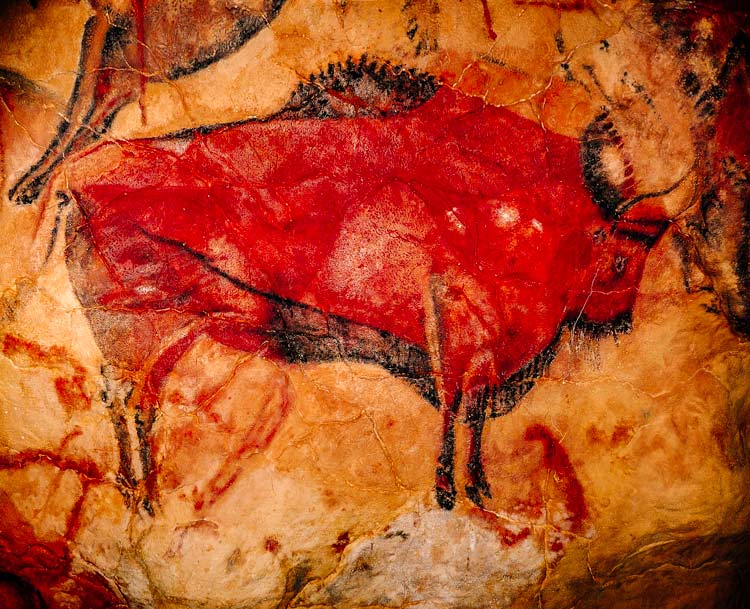
29. Altamira Cave, Cantabria
The Cave of Altamira is often touted as the Sistine Chapel of Paleolithic Art.
It is renowned for its prehistoric cave art featuring charcoal drawings of wild fauna and human hands.
The best known art illustrations in Altamira are on the polychrome ceiling, which features scores of bisons, besides other animals. The drawings were made using charcoal, and the artists apparently used the contours of the cave to give their illustrations a 3-D effect.
All the drawings are from the paleolithic period and have been preserved ever since.
The cave was opened to the public earlier but was shut when the paintings started getting damaged. It has remained closed, since, however there is a replica in the National Museum and Research Center of Altamira, which allows visitors.
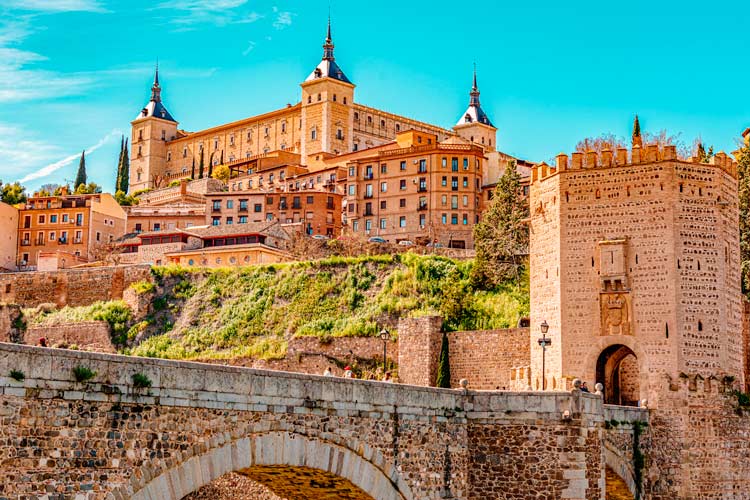
30. Imperial City, Toledo
Toledo is located in central Iberia on the banks of River Tagus.
The city contains over more than 2,000 years of history spanning from the Romans, through the Moors until the takeover by Catholic forces.
Toledo is also called the the “City of three cultures’ due to its collective cultural influences from Christianity, Judaism, and Islam.
Make sure to visit the cathedral, synagogue and the alcázar, all located within the walls of the city.
Toledo was declared a UNESCO World Heritage Site in 1986.
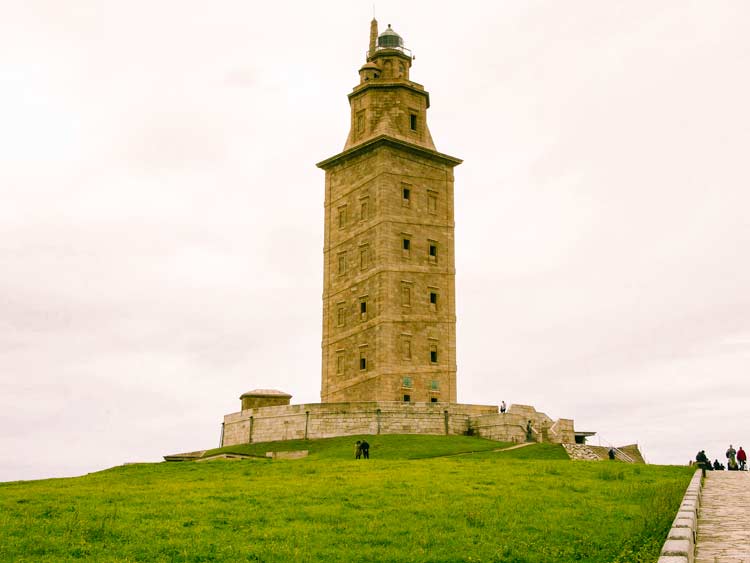
31. Torre de Hércules, La Coruna
One of Spain’s most ancient monuments, the Tower of Hercules is the oldest existing lighthouse in the world.
Located in La Coruna in Galicia, the lighthouse has served as an important landmark for the city since the 1st century AD.
The tower stands on a 55 meter-high rock, and has a length of 55 meters.
The Tower of Hercules has been a UNESCO World Heritage Site since 2009.
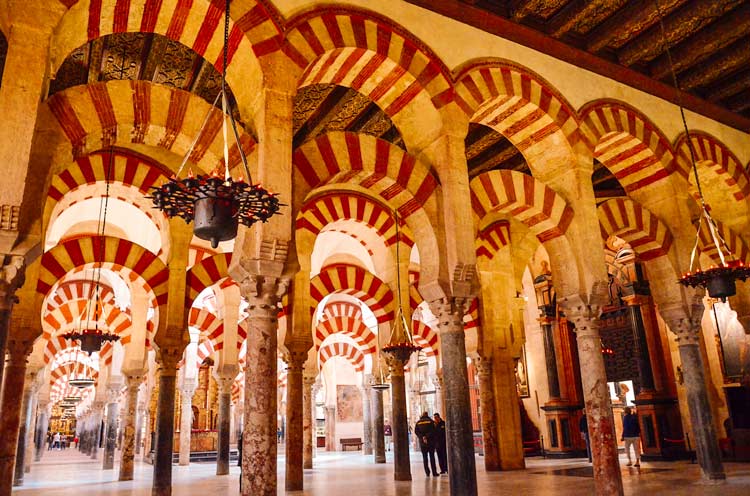
32. Mosque-Cathedral, Córdoba
The Mosque-Cathedral of Cordoba is considered a strategic landmark in the history of Spain’s Islamic architecture.
Originally built as a mosque, the monument was converted to a cathedral when Cordoba was captured during the Reconquista.
The mosque’s brick and stone arches are especially fascinating. Supported by over 800 marble and granite pillars, the arches create a magical light effect when sunbeams pass through them.
You can climb up the building’s bell tower, and enjoy a panned out view of Cordoba from the top.
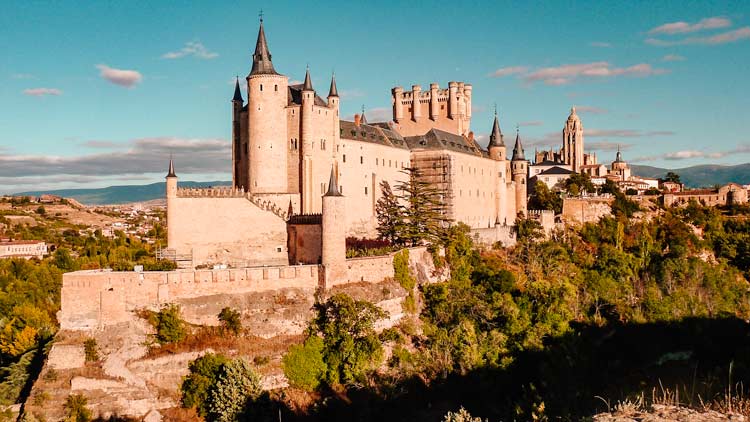
33. Alcázar de Segovia, Segovia
The Alcazar Fortress, a medieval castle located in Segovia, is a UNESCO World Heritage Site and a very important landmark in Spain.
What sets it apart is its unique shape; the castle protrudes like the bow of a ship. Its black graphite turrets also stand out and add to the already unique architecture.
The term Alcazar literally means fortress. Built in the Moorish period, the castle Alcazar of Segovia has been home to many notable families in Europe like the Habsburgs, the Bourbons, and members of the House of Burgundy.
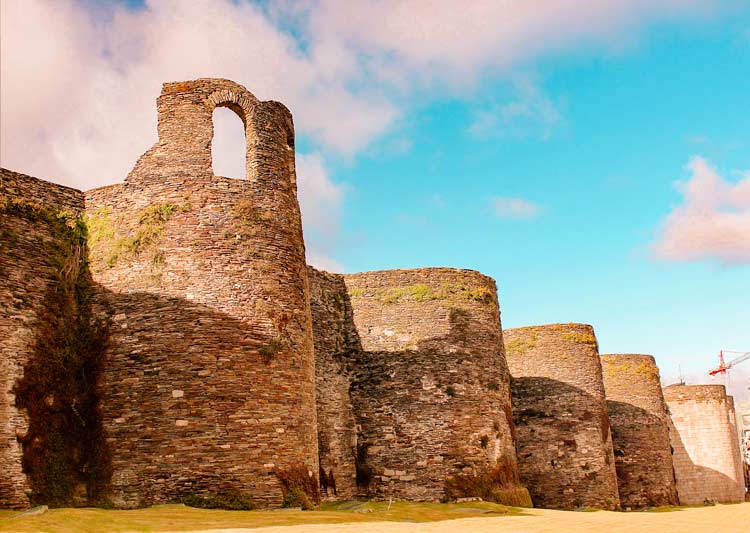
34. Muralla de Lugo
Another one of Spain’s UNESCO World Heritage Sites, the Roman Walls were built in the 3rd century. The walls are located in the city of Lugo in Spain’s Galicia region.
Constructed to protect the Roman town of Lucus Augusti against local tribesmen and Germanic invaders, the Walls of Lugo have stood more or less unscathed through longer than a millennia.
Visitors can now walk along the entire length of the walls. The city of Lugo also hosts an annual festival called Arde Lucus, dedicated to its Roman past.
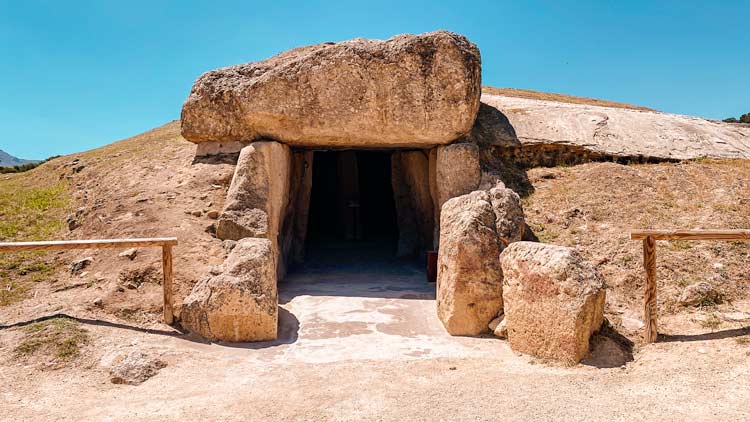
35. The Dolmens of Antequera, Andalusia
Nestled in Andalusia in Southern Spain is the town of Antequera. It is known for its ancient dolmens – megalithic tombs that were constructed in the past to commemorate the dead.
These dolmens have existed for thousands of years, and were possibly built in the Neolithic age. They were made out of large stone blocks, and are instantly reminiscent of the Stonehenge in the UK.
The Dolmen Site consists of three megalithic monuments: Dolmen of Menga, Dolmen of Viera and Tholos of El Romeral. There are also two natural monuments: the Peña de los Enamorados and El Torcal .
Even though these were declared a UNESCO World Heritage Site only recently in 2016, the Dolmens of Antequera are among the oldest and best preserved prehistoric landmarks of Europe.
RELIGIOUS LANDMARKS IN SPAIN
36. Santa Maria de Montserrat, Catalonia
Montserrat Monastery is located on the multi-peaked mountain range of Montserrat, about 50 km from Barcelona.
It is an important monument of Catholic pilgrimage as it enshrines the statue of the Virgin of Montserrat.
Near the monastery there is a natural park with plenty of great hikes.
Montserrat’s highest point, Sant Jeroni, is only a few steps away from the monastery. From here, you can see the whole of Catalonia – and even Mallorca, on a clear day.
Due to its proximity to the city, Montserrat is a popular day trip destination from Barcelona.
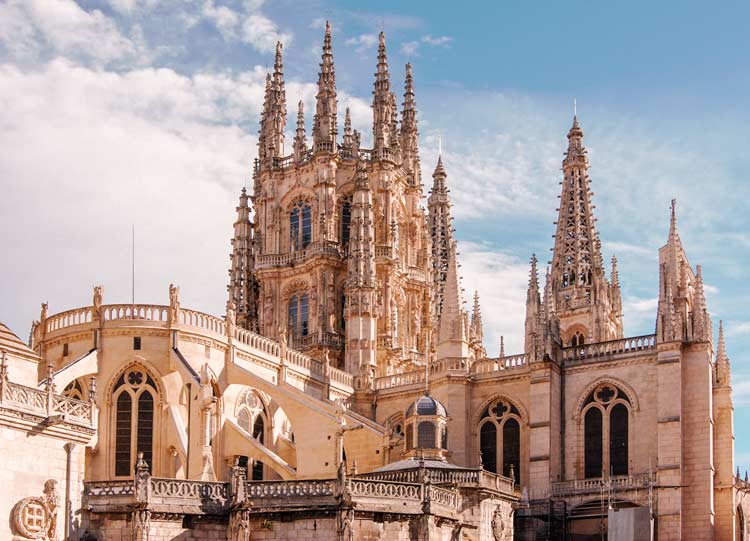
37. Cathedral of Saint Mary, Burgos
Burgos Cathedral is a Gothic church dedicated to the Virgin Mary.
It was built in 1221, but various embellishments and changes were made to the construction through the 15th and 16th centuries.
The cathedral was declared a UNESCO world heritage site in 1984, and is one of the most outstanding examples of Gothic architecture in Spain.
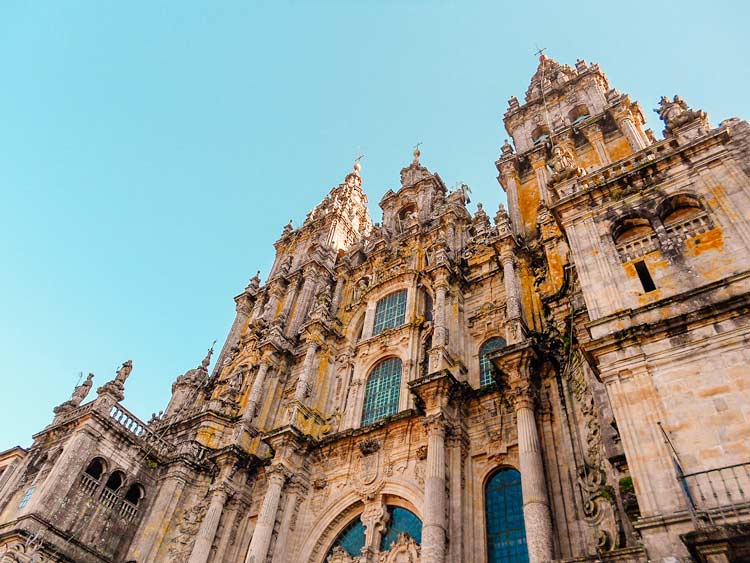
38. Santiago de Compostela, Galicia
The Cathedral of Santiago de Compostela is one of Spain’s most famous sights.
It is especially important as it is the final point on the Camino de Santiago pilgrimage trail. It is also the burial place of Saint James the Great, the apostle of Jesus Christ.
The Cathedral was first built in the late 10th century and then rebuilt on several occasions. The oldest parts of the current building date from 1075, but the facade was only finished in the early 14th century.
The cathedral is famous for its combination of Romanesque and Gothic styles, which was one of the first in Western Europe.
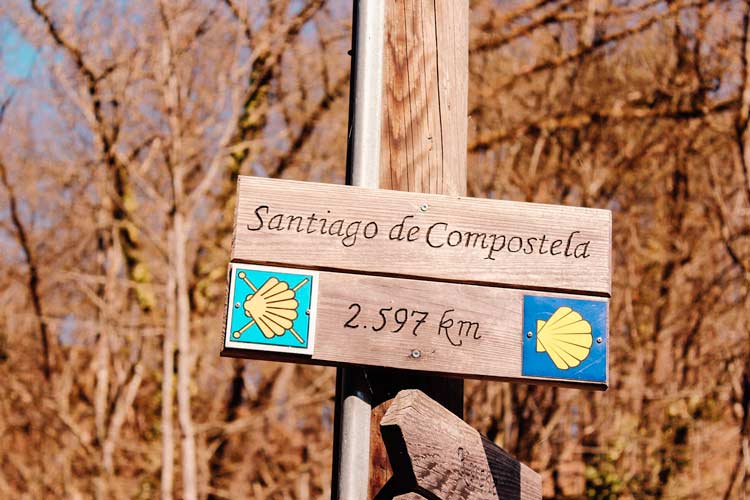
39. El Camino de Santiago, Spain
Not a monument but a mandatory mention on this list of landmarks in Spain, Camino de Santiago or the St. James’ Way is one of the most popular walking trails in the entire world. It takes you through some of Spain’s most scenic villages and towns and spans across rugged landscapes.
The Camino de Santiago has been a pilgrim trail since the 10th century.
Though traditionally the trail was to begin anywhere, now travelers mostly start at the St. Jean Pied de Port across the France-Spain border. The trail always ends at Santiago de Compostela Cathedral.
The Camino is an 800 kilometer-long pilgrimage that takes on different routes depending on your starting point.
Over 3,00,000 people walk the Camino every year, thus making it one of the most famous Spain landmarks.
NATURAL LANDMARKS IN SPAIN
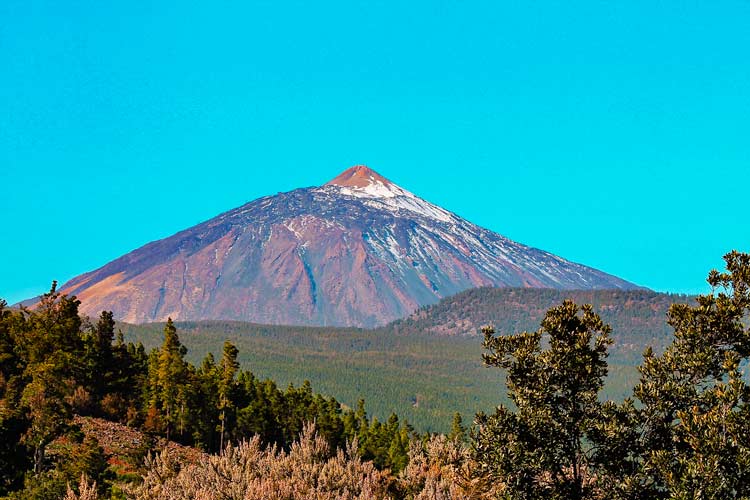
40. El Teide, Tenerife
While most landmarks in Spain are cultural or historical monuments, this one is a natural wonder that is worth knowing about and visiting.
El Teide is a volcano on the island of Tenerife, which is part of the Canary Island. At a height of 7500 meters, it is the third highest volcano in the world.
Teide is an active volcano, and its most recent eruption happened in 1909.
The Teide National Park (El Teide and its surrounding area) is the most visited national park in Europe and is visited by over 3 million people every year!
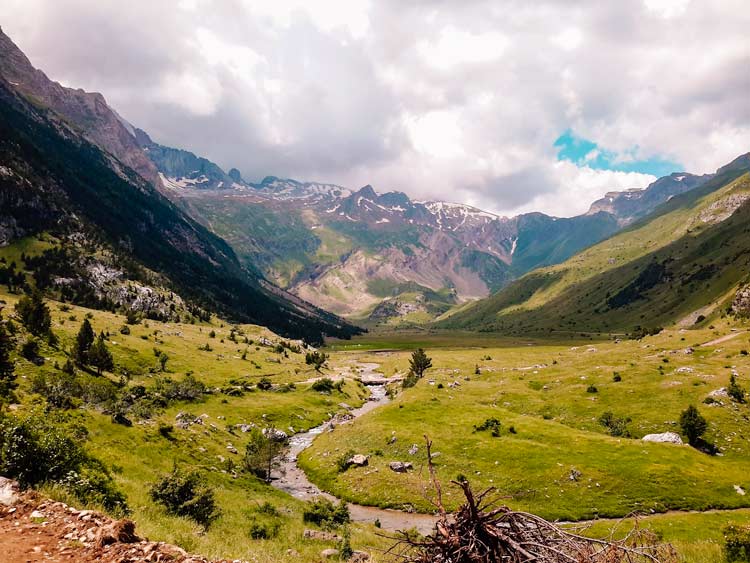
41. Monte Perdido, Pyrénées
Monte Perdido, or Mount Perdido, is one of the highest mountains in Spain, located in the Pyrenees mountain range.
It is located in the center of the Ordesa y Monte Perdido National Park, in the province of Huesca, and lies partly in both Spain and France.
Mount Perdido stands at 3,355 meters tall. Its peak lies on the Spanish side.
The whole area is full of many different hiking trails through alpine lakes and deep canyons. It’s one of the best ways to truly enjoy Spain’s incredible flora, fauna and natural wealth.
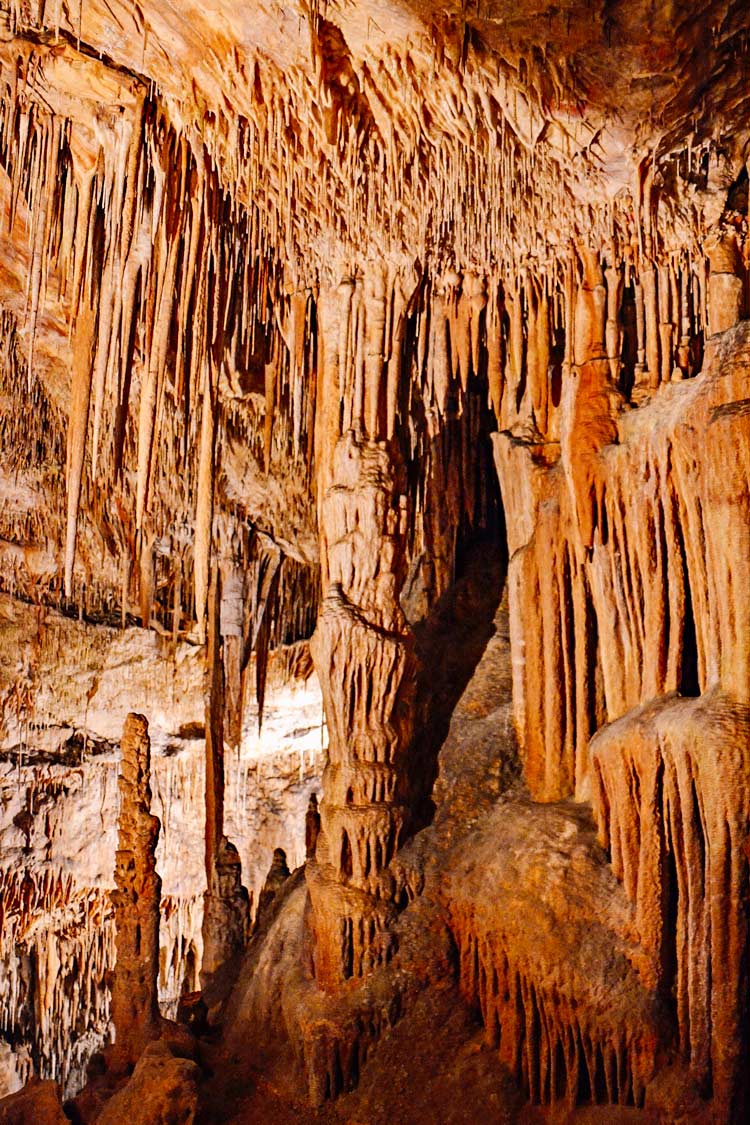
42. Cuevas del Drach, Majorca
The Caves of Drach, or Cuevas del Drach, are a group of four caves located on the east coast of Mallorca. They are a major tourist attraction on the island.
The Drach Caves were inhabited during prehistoric times (the stone age), although their first mention is in a letter dated 1338. The technique involved in their quarrying is indicative of the advanced knowledge and skill possessed by those who lived in this period.
The four caves, namely Black Cave, White Cave, Cave of Luis Salvador, and Cave of the French, are all interconnected.
There is an underground lake in the caves called Martel Lake, named after the French explorer Édouard-Alfred Martel, who discovered it.
At the end of the guided tour of the Drach Caves, there is a musical concert by an orchestra on a boat. It’s truly amazing!
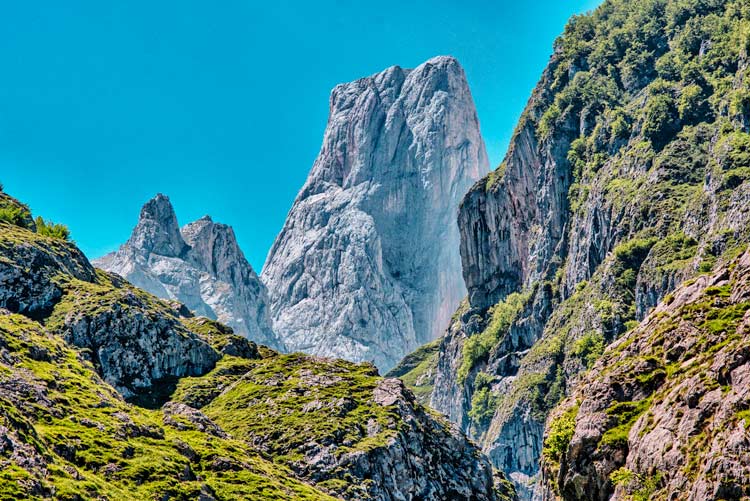
43. Torre de Cerredo, Cantabria
Torre de Cerredo, or Torre Cerredo, is one of the most famous natural landmarks of Spain.
At an elevation of 2,650 metres, Torre Cerredo is the highest peak of the Cantabrian mountains. It is also the highest peak of the mountain range of Picos de Europa.
The whole Picos de Europa region offers great opportunities for hiking and mountaineering. It has glacial lakes, deep gorges, tall peaks, and perfect wilderness. The breathtaking landscapes don’t hurt either 😉
MORE FAMOUS SPAIN LANDMARKS
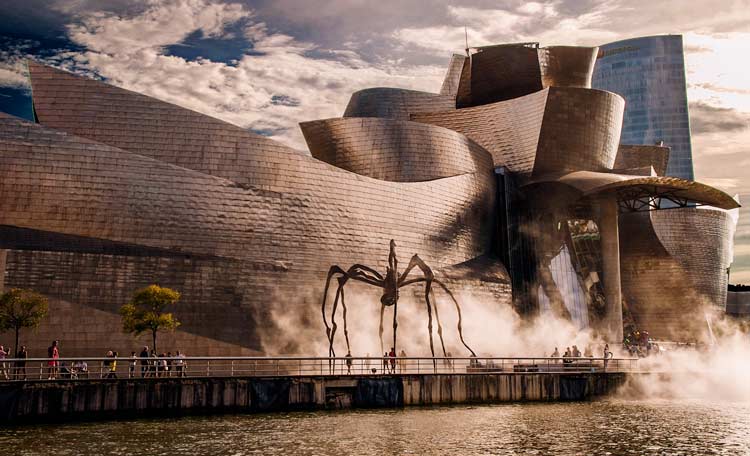
44. Guggenheim Museum, Bilbao
Guggenheim Museum is one of the many museums belonging to the Solomon R. Guggenheim Foundation.
Dedicated to honoring modern and contemporary art, the museum has a huge collection of artwork by Spanish and international artists.
The museum building, by itself, is a cornerstone of Spain’s architectural wealth. Truly avant-garde, the building glimmers in its glass and titanium-clad, gravity-defying exterior. The stunning chrome design is by Canadian-American architect, Frank Gehry.
Right outside is a giant spider installation by Louise Bourgeois and a puppy watchdog made of flowers (designed by Jeff Koons).
The Guggenheim Museum has put the city of Bilbao on the tourist map, and is a must-visit landmark in Spain.
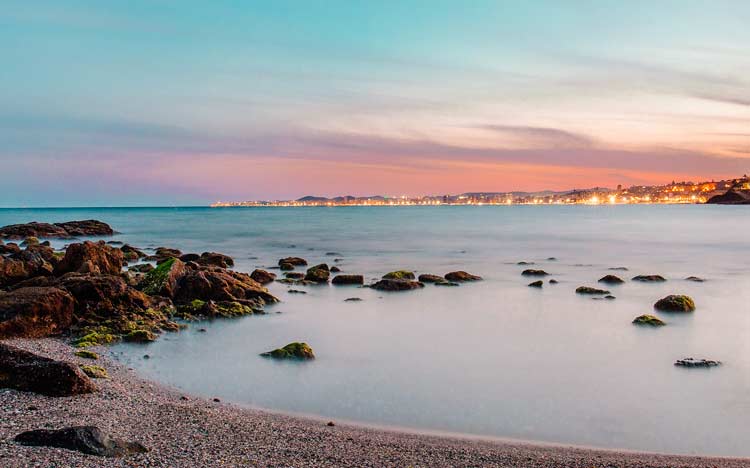
45. Costa del Sol, Malaga
Literally meaning “Coast of the Sun”, Costa del Sol lies in Andalusia, along the coastline of Malaga.
The region serves as a complete holiday destination in Spain with beaches, gastronomy, hikes, beautiful landscapes, water sports, and cruises.
Not only are there Mediterranean towns to explore, and national parks to hike through, Costa del Sol also has sophisticated beach resorts to unwind at.
Besides, it’s a great location to venture into Malaga, which was the birthplace of Picasso!
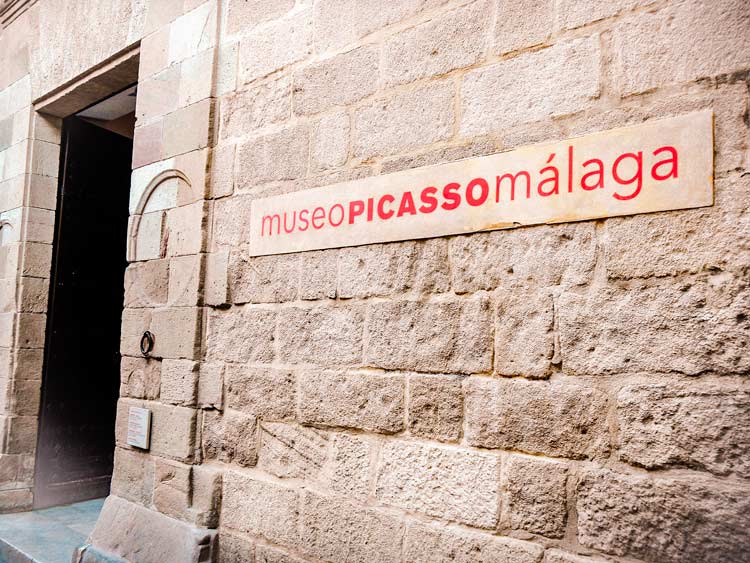
46. Museo Picasso, Malaga
As the name suggests, Museo Picasso is a museum dedicated to Pablo Ruiz Picasso. It is located in Malaga, his city of birth.
The museum contains 285 pieces of art by Picasso, from Cubism to Surrealism and Modern Sculpture.
You can’t visit Malaga and not pop in at the museum! It is convenient (and recommended) to book a tour in advance.
This tour is inexpensive, thorough, and with it you get a free audio guide to be able to truly admire Picasso’s genius.
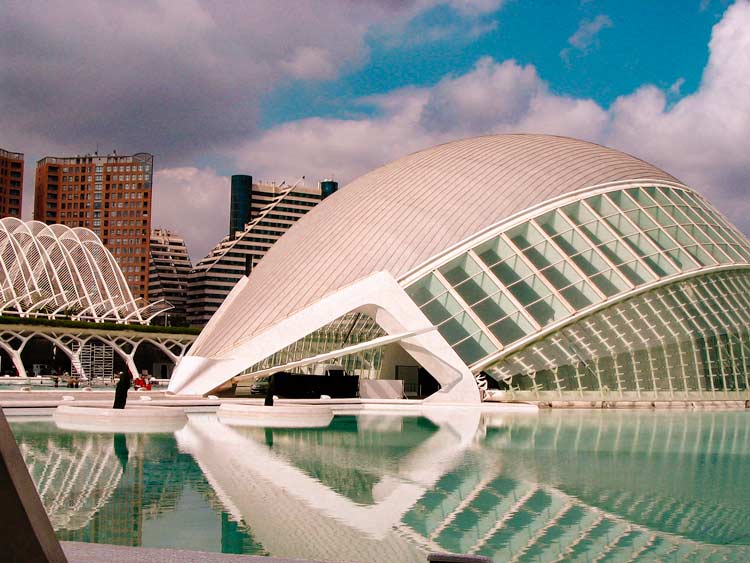
47. Ciudad de las Artes y las Ciencias, Valencia
A cultural complex in the heart of Valencia, this is one of the most famous landmarks of Spain.
The complex sits at the end of a beautiful concave park, which previously used to be a riverbed. After a flood in 1957, the river Turia flowing through it was drained and rerouted.
Literally translated to the “City of Arts and Sciences”, the complex contains a planetarium, museums, and an oceanographic park, besides other establishments. It really is like an entire city within a city!
The architecture is incredibly modern and futuristic. It’s nothing like I’ve seen before. The complex has served as a set for several movies and TV series.
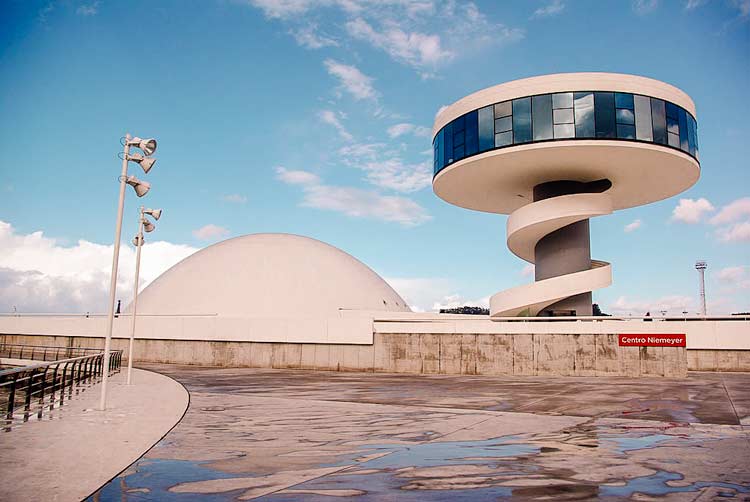
48. Oscar Niemeyer International Cultural Centre, Asturias
The Oscar Niemeyer International Cultural Centre, or Centro Niemeyer, was designed by the famed Brazilian architect Oscar Niemeyer.
The famous Spanish landmark is located in Avilés, Asturias, in the northern part of Spain.
Completed in 2004, the center was designed in honor of Spain’s beloved architect Antonio Gaudí. It features an absolutely stunning blend of sustainable architecture, art, and modern technology.
Its exterior is completely covered in marble. The center is formed by a complex pattern of curves and glass structures to create an incredible 3D effect.
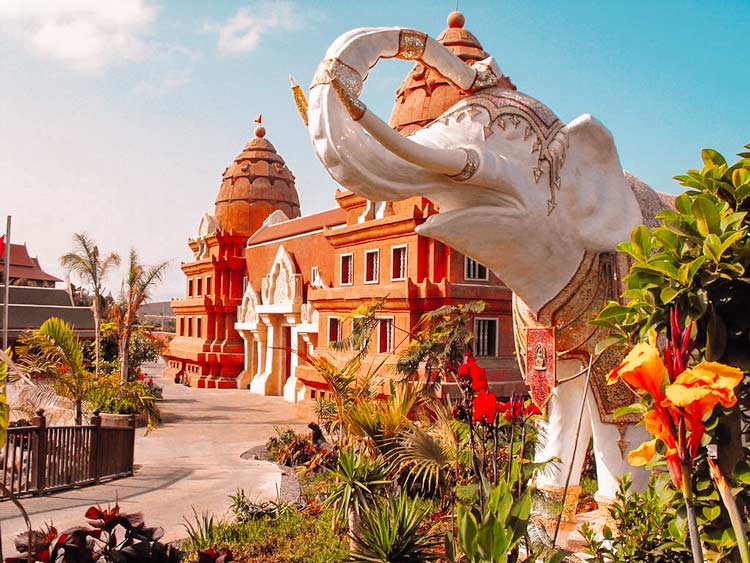
49. Siam Park, Tenerife, Canary Islands
One of the most popular water parks in Europe, Siam Park is a must-visit for those traveling to the Canary Islands.
The park is based on a Thai theme and has Thailand-based rollercoasters, water rides, parks, and restaurants.
It includes 25 buildings – the largest Thai-themed set of buildings outside of Thailand.
Siam Park was opened to the public in 2008 and is one of the most fun and famous destinations in Spain.
FINAL THOUGHTS
As you can see, there are many famous landmarks in Spain – from man-made to natural ones.
Looking to learn more about the incredible country? Here’s a roundup of 42 fun facts about Spain you probably didn’t know!
I hope this list has got you feeling inspired to travel to Spain soon. While visiting all the popular points of interest may not be possible, you should definitely include at least a few of these Spain landmarks in your itinerary. Each of them will surprise you and make your visit to Spain memorable!
Which of these is your favorite? Any famous and important Spain landmarks I’ve missed? Drop them in the comments below!
You Might Also Like:
************************************
This post might contain affiliate links. My full disclosure and privacy policy is really boring, but you can read it here.


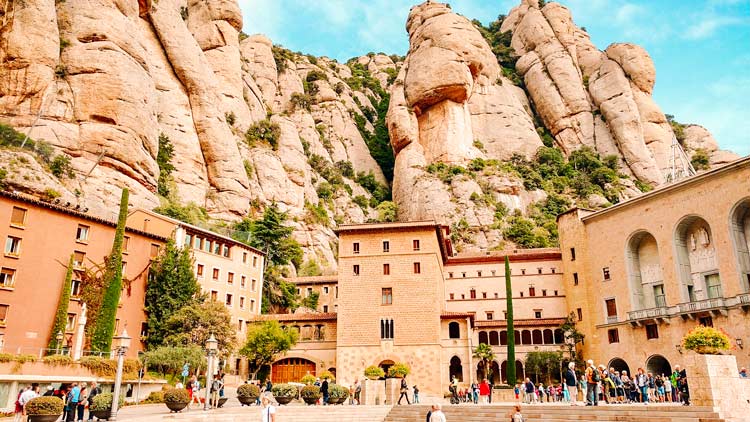


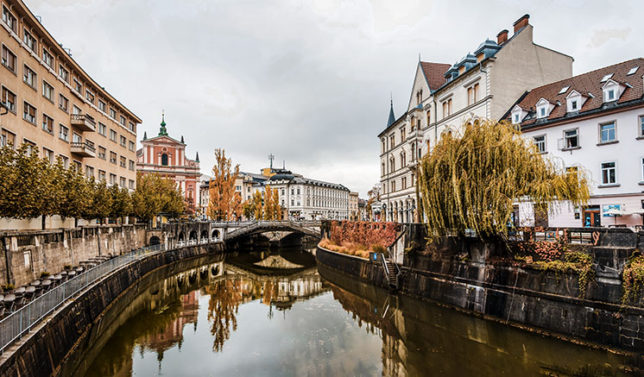
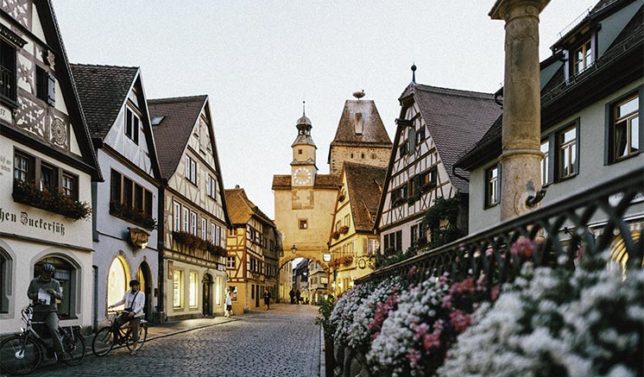
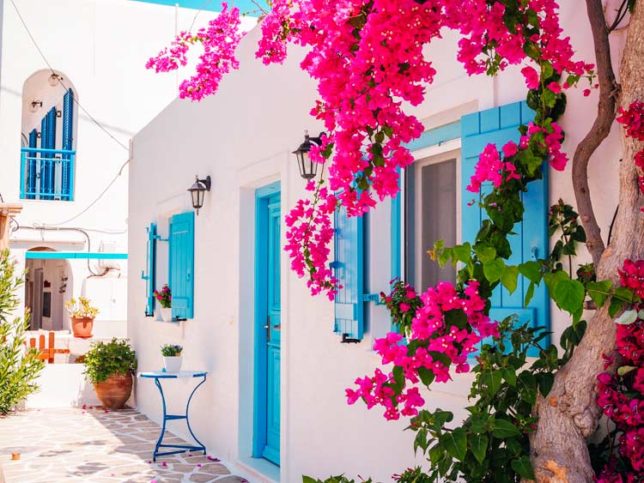
3 Comments. Leave new
That’s a lovely capture, really one with an eye of an artist.
bluepagemall
https://www.bluepagemall.com
Thank you!
Great looks. Very inspiring. What a great idea to distribute the various looks over the participating blogs! Very smart!
funsobastore | https://www.funsobastore.com